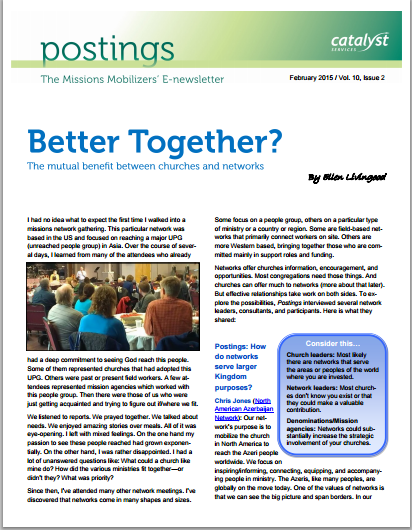Better Together?
There is a huge disconnect between local churches and mission networks.
Many international mission networks primarily involve representatives of mission agencies. Few networks proactively and strategically involve local churches.
An excellent article by Ellen Livingood of Catalyst Services offers some valuable advice for network leaders, church leaders, and denomination / mission agency leaders on the mutual benefit of involving local churches in mission networks.
Livingood is President of Catalyst Services, an organization that specializes in forging connections between local churches and mission organizations in order to expand and improve their global efforts. Catalyst also provides a variety of mission mobilization tools and training.
Interviews with leaders
In this article, Livingood writes:
“… networks come in many shapes and sizes. Some focus on a people group, others on a particular type of ministry or a country or region. Some are field-based networks that primarily connect workers on site. Others are more Western based, bringing together those who are committed mainly in support roles and funding. Networks offer churches information, encouragement, and opportunities. Most congregations need those things. And churches can offer much to networks. But effective relationships take work on both sides.”
To explore the possibilities of how churches can relate to networks, Livingood interviewed six leaders involved in local churches and mission networks.
These are the questions she asked:
- How do networks serve larger Kingdom purposes?
- How do networks serve congregations in the West?
- How can churches and their missions leaders maximize the benefits of involvement with a network?
- What are some ways that churches can contribute to the effectiveness of networks?
- How would a church go about determining if involvement in a particular network is valuable for their partners and themselves?
- What are the marks of a healthy network?
Key takeaways
For network leaders:
Most churches don’t know you exist or that they could make a valuable contribution.
For church leaders:
Most likely there are networks that serve the areas or peoples of the world where you are invested.
For denominations / mission agencies:
Networks could substantially increase the strategic involvement of your churches.
Next steps
For networks:
1. Make sure your website and written materials clearly spell out how you serve churches.
2. Outline multiple ways churches can serve you. Ask for their help.
3. Pair churches attending your meetings for the first time with more experienced partners.
For churches:
1. Visit a network meeting.
2. Get to know the network facilitator and leadership team.
3. Start at whatever level of involvement you can — but just start!
For mission agencies:
1. When you commission new workers, challenge their sending church to join a network.
2. Feature a network — or several — on your website or in publications.
3. Ask your church mobilizers to each serve at least one network.
What networks can offer to churches
1. Access to key leaders and current information about a broad scope of highly strategic ministries
2. Ownership of a big vision
3. Coaching by experienced facilitators that helps churches avoid mistakes and expand impact
4. Shared prayer requests and answers
5. Collaboration on projects too large for any one entity to accomplish
6. Encouragement to “stay the course” to see results
7. Opportunities to help shape strategy
8. The model of other committed churches
Read more
Read the full article (PDF)



FYI, there is a current discussion group on this topic running here on the Commons during this month.
Here’s the link:
Engaging The Local Church In Field-Based Networks
https://synergycommons.net/groups/engaging-the-local-church-in-field-based-networks/